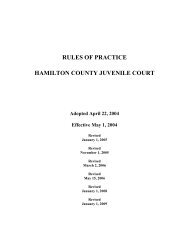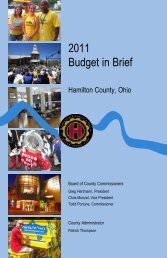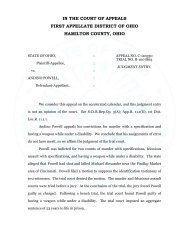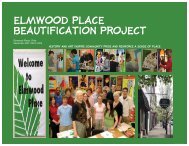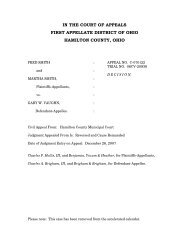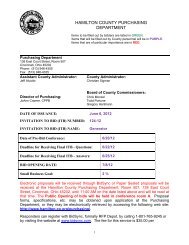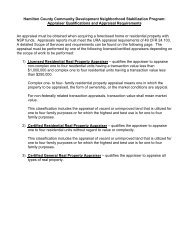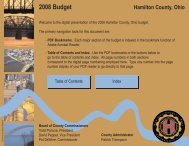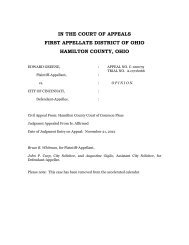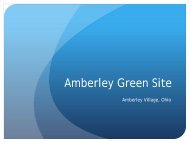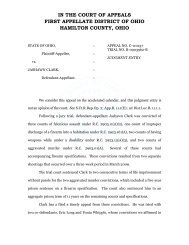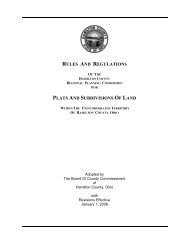Planning Commissioners' Procedures Manual - Hamilton County, Ohio
Planning Commissioners' Procedures Manual - Hamilton County, Ohio
Planning Commissioners' Procedures Manual - Hamilton County, Ohio
Create successful ePaper yourself
Turn your PDF publications into a flip-book with our unique Google optimized e-Paper software.
THE PLANNING PROCESS<br />
The <strong>Ohio</strong> Riverfront Area Land Use <strong>Planning</strong> Committee composed of a cross section of<br />
interests was created by the Board of Township Trustees to advise staff and consultant and<br />
provide guidance to this planning effort. The planning process included a series of meetings<br />
with the Committee, a public open house, and Township officials. Furthermore, Township staff<br />
conducted supplemental meetings with other interested property owners in the study area.<br />
The <strong>Ohio</strong> River Land Use Committee met four (4) times from the Fall of 2001 to the Spring of<br />
2002. These meetings developed and refined future visions of the Anderson Township Riverfront<br />
area and other concerns about development trends along US 52. In the first meeting on<br />
September 12, 2001, the following goals and objectives were identified:<br />
GOALS AND OBJECTIVES<br />
• Create a comprehensive land use plan for the development of the study area for the next<br />
5 years<br />
• Make recommendations toward the issues which specific zoning and subdivision<br />
regulations should address<br />
• Promote sustainable economic development, making use of the riverfront assets and<br />
amenities<br />
• Develop land uses that are compatible with current and future amenities such as the future<br />
<strong>Ohio</strong> River Trail<br />
• Improve access to <strong>Ohio</strong> River recreation, entertainment and businesses<br />
• Preserve and respect historic and cultural resources of the area and incorporate them in<br />
future development, as appropriate<br />
• Enhance and preserve greenspace, environmental quality, viewsheds (an area on the<br />
ground that is visible from a specified location), and overall aesthetics of the riverfront study<br />
area<br />
q Kellogg Ave./US 52 should be maintained as a scenic corridor<br />
q Protect views from and to hillsides and <strong>Ohio</strong> River<br />
q Preserve and respect flood plain and hillside greenspace<br />
q<br />
Facilitate development that is in harmony with the natural and man-made resources of<br />
the area<br />
• Seek to minimize negative impacts from development (such as noise, light, and air pollution<br />
as well as traffic congestion)<br />
NATURAL FEATURES and PHYSICAL ANALYSIS<br />
Existing conditions were analyzed prior to the creation of the Conceptual Land Use Plans.<br />
Presented to the <strong>Ohio</strong> Riverfront Area Land Use Committee at the September 12, 2001<br />
meeting, this included analysis of the following:<br />
• Existing conditions to identify land use, zoning, and infrastructure. (Figure 1)<br />
• Natural features including slope, soil conditions, hydrology, and vegetation.<br />
• Visual Resources such as key views and important visual features.<br />
A summary analysis that identifies the suitability of land for development/preservation was<br />
created. (Figure 2) Based on slopes, floodway and soil type, this analysis qualitatively<br />
evaluated the appropriateness of development for land throughout the study area. The<br />
following criteria were utilized:<br />
ANDERSON TOWNSHIP OHIO RIVERFRONT AREA LAND USE PLAN<br />
Page 2



